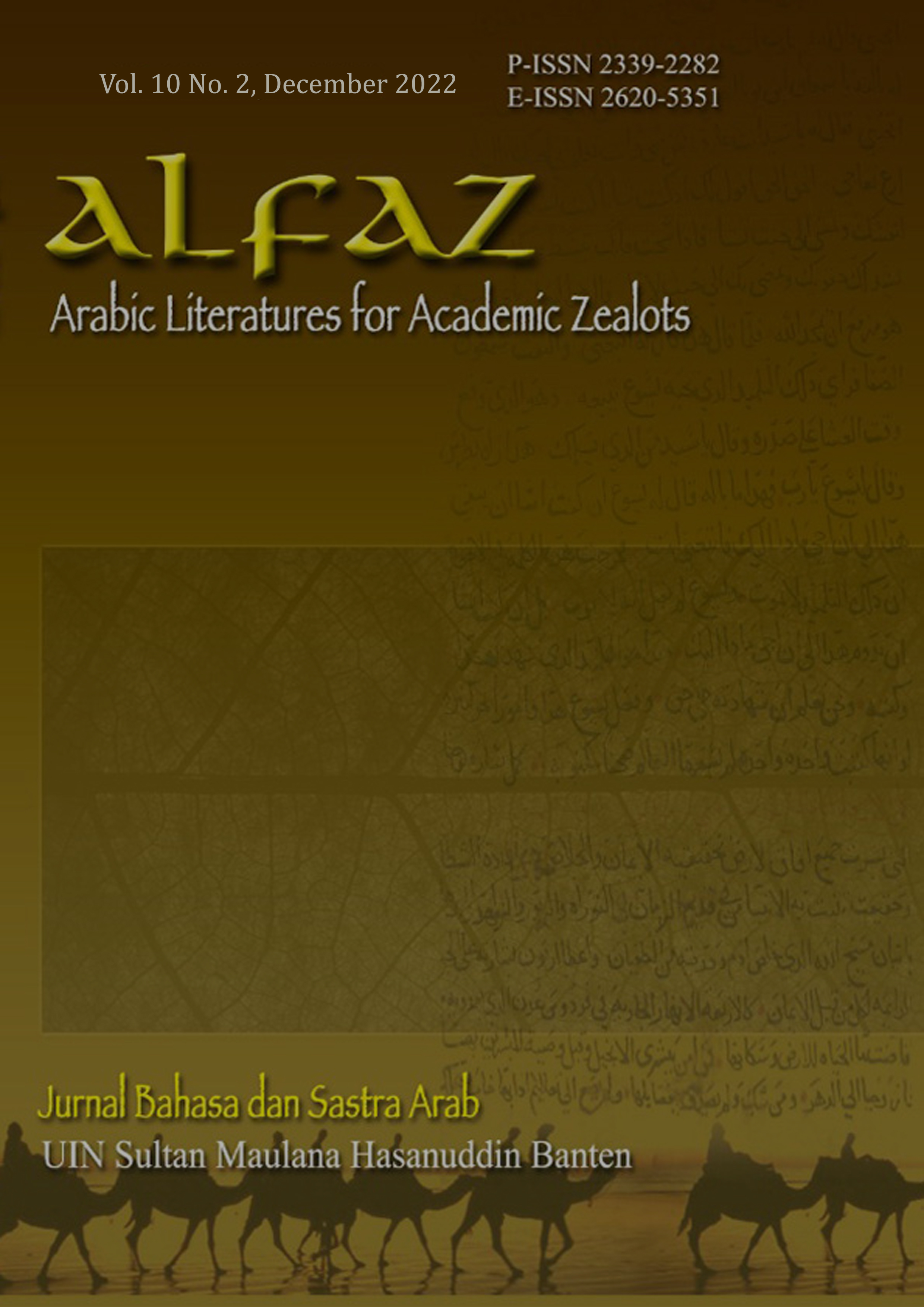Unsur-Unsur Sastra Arab: Kajian Kritik Sastra Objektif Pada Buku Cerita Bergambar Al Bintu Mitslul Walad
DOI:
https://doi.org/10.32678/alfaz.Vol10.Iss2.5761Keywords:
Literary Elements, Objective Criticism, Picture Story BookAbstract
Abstract: Al Bintu Mitslul Walad (BMW) picture story book by Fatimah Al-Ma'dul, is one of the children's literary. The BMW book tells the story of a girl named Salma who asks justice for her rights. She can't play the games she wants, because she's a girl. He continues to do his best to achieve justice for his rights, but in some actions are found that are not in harmony with the actions of the child figures. So in this study, the researcher wanted to identify and give an assessment of the literary elements in the BMW picture story book. Descriptive qualitative method is used in this research with Abrams' objective criticism approach and literary elements according to Ahmad Syayib. The study results indicate that the emotions and form elements in the BMW picture story book are in accordance with the characteristics of children's literature. As for the imaginations and facts elements, the researchers found a discrepancy with the characteristics of children's literature. This is due to the interference of adult thoughts, namely Al Ma'dul as the writer of the BMW picture story book.
Downloads
References
Amin, Ahmad. An Naqd Al Adabiy. Kairo: Hindawi, 2012.
Assa’adah. “Analisis Unsur-Unsur Intrinsik Dalam Syi’ir (Radhitubillahi Rabba) Oleh Maher Zain.” Universitas Sumatera Utara, 2018. https://repositori.usu.ac.id/bitstream/handle/123456789/5236/130704018.pdf?sequence=1&isAllowed=y.
Darmiah. “Perkembangan Dan Faktor-Faktor Yang Mempengaruhi Emois Anak Usia MI.” Pionir: Jurnal Pendidikan 8, No. 2 (2019). https://jurnal.ar-raniry.ac.id/index.php/Pionir/article/view/6230.
Djollong, Andi Fitriani. “Al Mar’ah Dalam Al Quran.” Jurnal ISTIQRA 6, No. 1 (2018). https://jurnal.umpar.ac.id/index.php/istiqra/article/view/473.
Ferber, Alona. “Women in the ‘New Egypt’: What Next?.” Tel Aviv Notes: An Update on Middle Eastern Developments 5, No.24. (2011). http://dayan.org/file-download/download/public/15828.
Husna, Raudhatul. “Kritik Sastra Objektif Lirik Laguالدين السلام (Din As Salam) Yang Dinyanyikan Oleh Sulaiman Al Mughani.” Universitas Sumatera Utara, 2021. https://repositori.usu.ac.id/bitstream/handle/123456789/43705/170704037.pdf?sequence=1&isAllowed=y.
Ibda, Fatimah. “Perkembangan Kognitif: Teori Jean Piaget.” Jurnal Intelektual 3, No. 1 (2015). https://www.jurnal.ar-raniry.ac.id/index.php/intel/article/view/197.
Miles dan Huberman. Analisis Data Kualitatif. Jakarta: Universitas Indonesia Press, 1992.
Munawwir, Ahmad Warson. Kamus Al-Munawwir Arab-Indonesia. Surabaya: Pustaka Progressif, 1997.
Muzzaki, Akhmad. Pengantar Teori Sastra Arab. Malang: UIN Maliki Press, 2011.
Nashir, Muhammad Abdun. “Qua Vadis Feminisme Timur Tengah ‘Dilema Gerakan Wanita Di Mesir.’” Team Pusat Strudi Wanita (PSW), IAIN Mataram, 2007. http://www.academia.edu/3455630/Quo_Vadis_Feminisme_Timur_Tengah_Dilemma_Gerakan_Wanita_di_Mesir?auto=download.
Nurgiyantoro. Sastra Anak Pengantar Pemahaman Dunia Anak. Yogyakarta: UGM Press, 2005.
Pradopo, Rachmat Djoko. Teori Kritik Dan Penerapannya Dalam Sastra Indonesia Modern. Yogyakarta: Gajah Mada University Press., 2017.
Rahmi, Nadia. “Perbandingan Kritik Sastra Masa Umayyah Dan Abbasiyyah.” Jurnal ALFAZ 9, No. 1 (2021). http://jurnal.uinbanten.ac.id/index.php/alfaz/article/view/4648.
Rumidjan. Dasar Keilmuan Dan Pembelajaran Sastra Anak SD. Malang: FIP UM, 2013.
Sudaryanto. Metode Dan Aneka Teknik Analisis Bahasa. Yogyakarta: Duta Wacana University Press, 2015.
Syayib, Ahmad. Ushulu An Naqd Al Adabiy. Kairo: Maktabah An Nahdiyyah Al Mishriyyah, 1994.
Downloads
Published
Issue
Section
License
Copyright (c) 2022 Firstiyana Romadlon Ash Shidiqiyah

This work is licensed under a Creative Commons Attribution-NonCommercial-ShareAlike 4.0 International License.
Authors retain copyright and grant the journal right of first publication with the work simultaneously licensed under a CC BY NC SA License that allows others to share the work with an acknowledgement of the work's authorship and initial publication in this journal.







